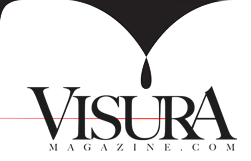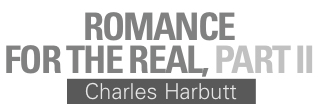
In the first chapter, I pointed out that the human ability to draw appears to have evolved from our primate ancestors, with whom we share that paleomammalian—visual, emotional—brain. Unfortunately, no sightings have been reported of gorillas drawing in the wild. Perhaps the researchers were so focused on the conscious topics of their academic studies they didn’t SEE the drawings in the sand. They were blinded by what they were looking for.
Therefore, we can say, in the beginning was the picture. For 25,000 years before the word, there was the picture. Before ART, there was the picture. Before critics and curators, semioticians and dealers, there were and are the image-makers. Even so, the question remains, why did people start to do it?
For me, the answer seems to be the effort to escape time, to escape death by poignantly leaving a record, some physical evidence of our passing, our fragile and dangerous life. In the first written epic myth, the quest of Gilgamesh is for immortality. While we call the thousands of years before written words pre-history, the visual objects we have found tell us a great deal about what the world was like at that time. Although, since we have none of the written records we so uncritically trust, we guess a lot, theorize, and project, much as the first conscious human beings were trying to figure out how their world worked.
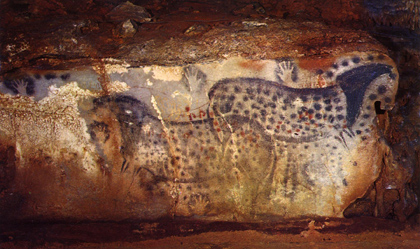
Pech Merle cave, France
One thing the paintings show is that the people had no sense of boundaries; the paintings cover the walls, the ceiling and one another. Of course, there were no borders in the world then. Most of the drawings were of their animal buddies, who shared the earth with them and gave them food. They also show how dangerous that world was for these first human predatory hunters.
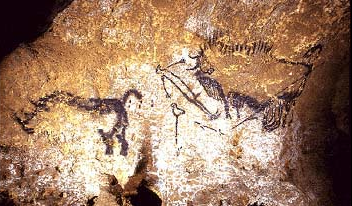
Death of a Hunter, Lascaux Cave, France
The caves also show that an image-making system like photography in which a subject in actuality makes its own picture may not be as new as we think; this romance for the real in images dates to the very beginnings of language and imagery.
In the first prehistoric cave I visited, I walked into a darkened fissure in the side of a hill and, when the lights went on, encountered a dead-sure drawing of a bison surrounding a perfectly rounded outcropping of rock that suggested the volume of a bison’s torso. The painter had outlined the bison with a single continuous stroke. The experience was exciting, but strangely like any museum visit: an encounter with the wit, imagination and control of an artist. Even to mixing sculpture and drawing. And to the use of metaphor, the very basis of poesy:
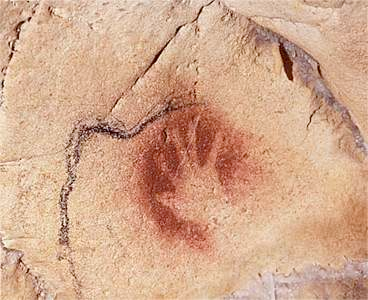
Handprint from the Chauvet Cave, 30,000 years ago
Lon Battista Alberti, a fifteenth century architect, philosopher and code maker, credited as being a major Renaissance thinker, a model of the Renaissance man, had a theory about the beginning of drawing long before we knew of the cave paintings. In his De Statua, he says: “I believe that the arts that aim at imitating the creations of nature originated in the following way: in a tree trunk, a lump of earth, or in some other thing were accidentally discovered one day certain contours that needed only a very slight change to look strikingly like some natural object. Noticing this, people tried to see if it were not possible by addition or subtraction to complete what still was lacking for a perfect likeness. Thus by adjusting and removing outlines and planes in the way demanded by the object itself, men achieved what they wanted, and not without pleasure. From that day, man’s capacity to create images grew apace until he was able to create any likeness, even when there was no vague outline in the material to aid him.” Or in fact anything real that the pictures and sculptures were like.
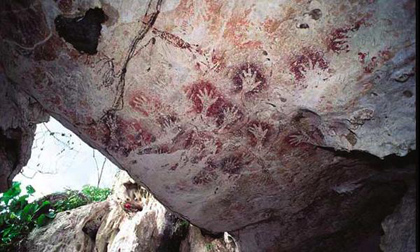
Cave in Borneo
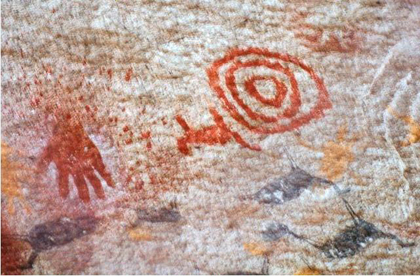
Las Cuevas de los Manos, Argentina
Moving on, I turned a corner and confronted my first handprint. That moment was electric: not only as imagery, but also as a direct encounter across thousands of years with a human’s physical presence. The painters had either dipped a hand in ochre and splayed it on a wall or, as above, took a mouthful of ochre and sprayed it around their hand, which acted as a stencil. Any photographer could tell you that these handprints look like positive and negative photograms in which ochre was used instead of light. Clearly the romance for images of “reality,” the impulse to make a thing itself produce its image, a workable definition of photography, is as old as the human impulse to draw.
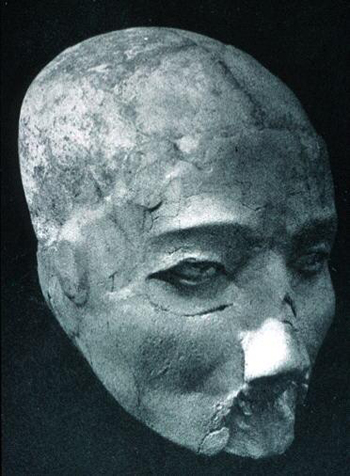
© 2001-2011, The Virtual Fossil Museum
There are many guesses (called theories) as to the purpose of the cave drawings. Drawing may have been a kind of voodoo technology: to outline was to control. In some shamanistic rituals, hunters dress in animal skins to gain power over their prey.
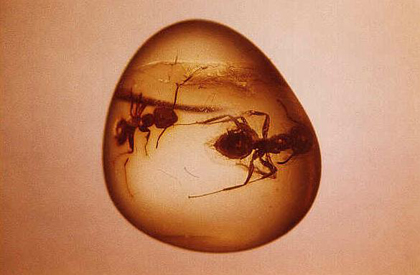
Maybe the paintings were an early form of movies with a storyteller moving from painting to painting with a torch. Maybe they were training films: “This is a bison; kill it! This is a jaguar; hide!” One researcher suggests the drawings were the work of teenage boys, like today’s graffiti artists (FYI – Some were/are girls.). Another proposes that such an explanation is just a way of bypassing the likelihood that the first artists were women, gatherers with small hands waiting for their men to return from the hunt. The handprints were their signatures. Actually, research now suggests the handprints were made by both sexes. Perhaps they were to show “We are humans here. We made this.” Like the abstract drawing of a man and woman on the outside of the spaceships, perhaps, their purpose was only to show that drawings and sculptures could be made. For the sport of it, like any art today.
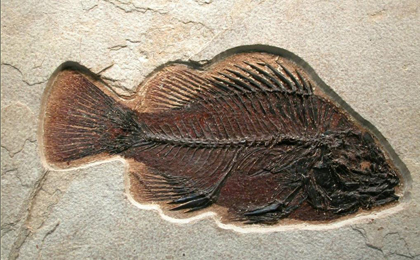
© 2001-2011, The Virtual Fossil Museum
The lack of a photographic technology I imagine played a major role in the development of drawing, rather than thing-it-selfing. Imagine trying to dip a bison in ochre and persuading it to snuggle up to a wall. Or a jaguar. So the artists turned to drawing as the safer technology. But handprints appeared in cultures all over the world: “I splatter, therefore I am…forever.” As they evolved, both drawing and different forms of thing-itselfing persistently and consistently appeared to assault the power of time to obliterate a life.
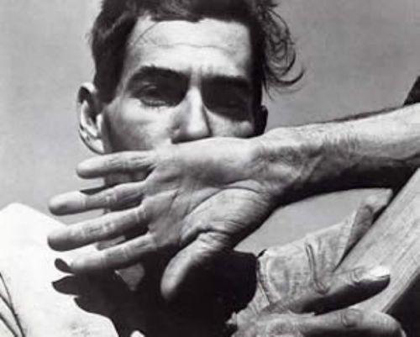
Photograph by Dorothea Lange
The hand prints travelled all over the world even as far south as Patagonia at the tip of South America.
Unfortunately, the time between the caves and the first cities is not well known; the next phase of visual art seems almost to have sprung full blown especially in its ability to depict humans. Drawing seems to have jumped from stick figures to more fleshed out ones overnight (in evolutionary terms).
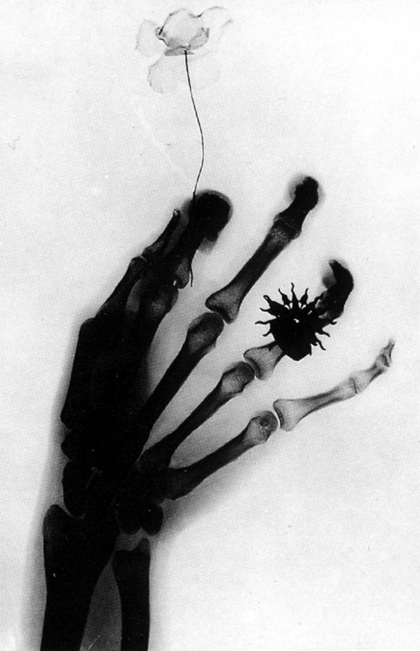
Photo by Manuel Alvarez Bravo
A startling exception was the tradition of skull portraits, death masks, from Jericho. Once again, early humans were struggling to make something permanent of their lives and turned to the real and its metaphors. The ancestors were buried upright and the face was visible above the floor of the house. The head was covered with mud and cowrie shells, which look like eyes, were inserted in the eye-sockets. The whole gory mess was baked in the desert sun around 7000 BCE and the results are considered the first portraits because of their individuality.
As time went on, other kinds of reality-preserved objects became popular. Amber, for instance, surfaced as jewelry. On his quest for eternal life, Gilgamesh encounters a brilliant garden of gems, where every tree bears precious stones. Amber is sap that drips on an insect.
A drop of amber, from the weeping plant,
Fell unexpected, and embalm’d an ant;
The little insect we so much condemn
Is, from a worthless ant, become a gem
Book vi, Epigram xv — Martial
Fossils were also prized, some as jewelry. What is clear is that by the time of the first civilizations, we had learned that there is no inherent connection between drawing and anything in reality. Paintings can exaggerate or even deal with the unseen, like gods.
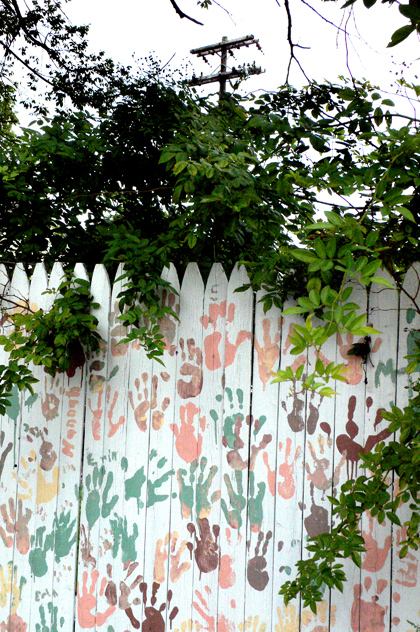 Photo by Charles Harbutt
Photo by Charles Harbutt
Many photographers have honored their forebears with hand pictures. Here’s an x-ray version by Manuel Alvarez Bravo. And a photograph by Dorothea Lang
Hand prints are deep in our cultural evolution and history. Here’s one by the children of my village in upstate New York. And one by me. (right) Mine is a hypogram. I dipped my hand in hypo (fixer) and slapped it onto a piece of exposed paper. The hypo prevented development. 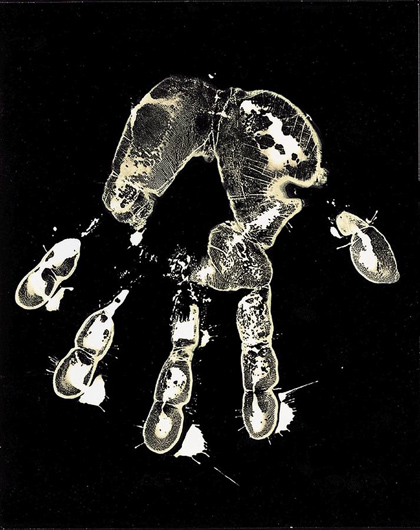 Photo by Charles HarbuttBut there’s high detail (the whorls of my palm print) without a lens, the illusion of stop action without a shutter (the spray of the splattered hypo). But as the print came up in the developer, it looked to me like some predatory, prehistoric squid, a likeness of one of my ancestors, I bet.
Photo by Charles HarbuttBut there’s high detail (the whorls of my palm print) without a lens, the illusion of stop action without a shutter (the spray of the splattered hypo). But as the print came up in the developer, it looked to me like some predatory, prehistoric squid, a likeness of one of my ancestors, I bet.
And one by me.
www.actualityinc.com
*This article is based on an academic lecture by Charles Harbutt





